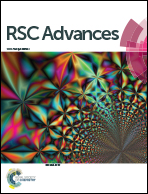Largely improved electromechanical properties of thermoplastic dielectric elastomers by grafting carboxyl onto SBS through thiol–ene click chemistry
Abstract
In this study, we report an approach to graft carboxyl groups onto the polybutadiene (PB) domains of a styrene–butadiene–styrene triblock copolymer (SBS) through thiol–ene click chemistry to prepare a homogeneous thermoplastic dielectric elastomer with largely improved electromechanical properties. The grafting degree of the carboxyl groups dipoles on SBS can be controlled by irradiation time to control the polarizability and thus the electromechanical properties of SBS. The tensile strength of modified SBS significantly decreases due to the improved miscibility of polystyrene (PS) and PB domains but still greater than 1 MPa. Importantly, the dielectric constant (εr) at 1000 Hz largely increased from 2.2 for pristine SBS to 7.2 for modified SBS with the grafting degree of 83%, ascribed to the increase in the polarizability of modified SBS by grafting the carboxyl groups on the PB block. The maximum actuated strains increased to 1.75% for modified SBS with a grafting degree of 52%, which is almost a 4-fold increase over that of pristine SBS (0.47%). This study provides us with a simple, effective and controllable method to synthesise homogeneous thermoplastic dielectric elastomers with largely improved dielectric constants and actuated strain.


 Please wait while we load your content...
Please wait while we load your content...